This website has been archived from TrainWeb.org/girr to TrainWeb.US/girr.
This website has been archived from TrainWeb.org/girr to TrainWeb.US/girr.
The LALS has a complete operating automatic block control system utilizing signals all around the line. The system is designed for fully bidirectional operation. Many of the regular signal can be seen on other photographs, this page is dedicated to the signal and turnout control system itself.
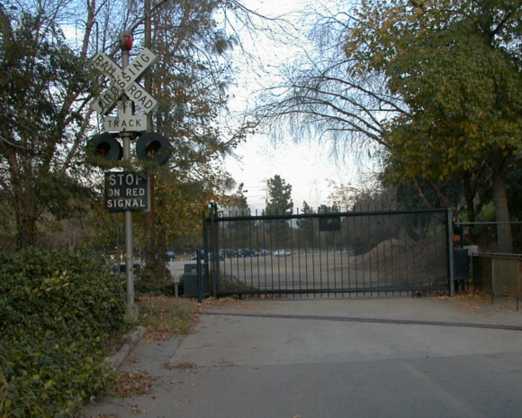 There are several
operating grade crossing signals at the LALS. This one is at the
main member's entrance where the driveway crosses the main line.
This signal is very useful because a driver entering or leaving the
facility does not have a very good view down the track in both
directions.
There are several
operating grade crossing signals at the LALS. This one is at the
main member's entrance where the driveway crosses the main line.
This signal is very useful because a driver entering or leaving the
facility does not have a very good view down the track in both
directions.
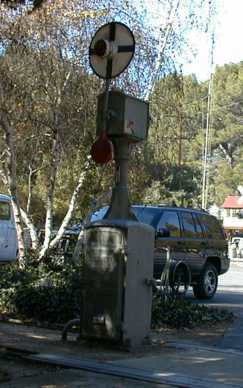 A wigwag signal is located in the next place where
the driveway crosses several yard tracks and enters the main inside
parking area.
A wigwag signal is located in the next place where
the driveway crosses several yard tracks and enters the main inside
parking area.
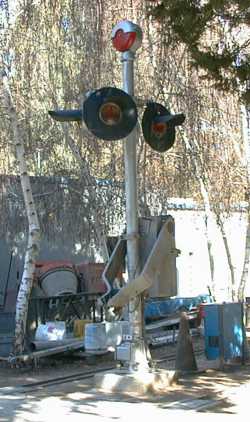 A crossing
gate is slowly being installed at the same crossing as the wig wag
signal.
A crossing
gate is slowly being installed at the same crossing as the wig wag
signal.
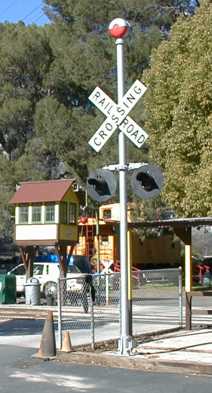 Yet
another driveway crosses both main line, station and yard tracks at
the passage between the main interior parking lot and a smaller
parking area that allows access to a jack for loading and unloading
engines onto the visitor's steamup bays for both 1" and 1-1/2"
scale equipment. This is a flashing light, bell and crossbuck
signal.
Yet
another driveway crosses both main line, station and yard tracks at
the passage between the main interior parking lot and a smaller
parking area that allows access to a jack for loading and unloading
engines onto the visitor's steamup bays for both 1" and 1-1/2"
scale equipment. This is a flashing light, bell and crossbuck
signal.
 Out on the "west end"
there is a signal bridge that spans two of the three main line
tracks.
Out on the "west end"
there is a signal bridge that spans two of the three main line
tracks.
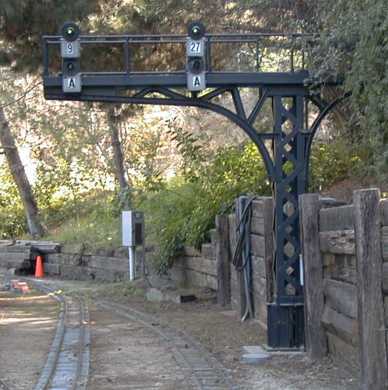 On the main where is
passes behind the car barns, a signal tower guards the track. These
are fully operational signals.
On the main where is
passes behind the car barns, a signal tower guards the track. These
are fully operational signals.
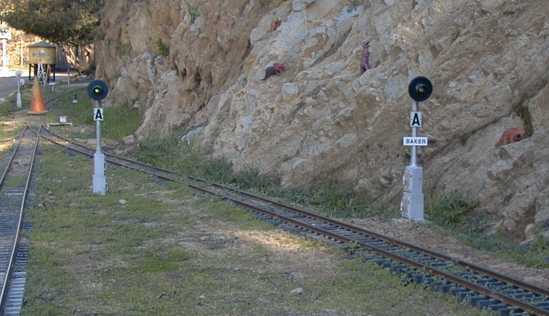 Much of
the main line is protected with single target signals. Some of
these will show three indications, green, yellow and red. A few
will show only yellow and red due to permanent slow orders. The "A"
designator on a signal is an absolute indication. This signal may
not be passed if it is red. A signal without an "A" posted may be
passed with caution at reduced speed.
Much of
the main line is protected with single target signals. Some of
these will show three indications, green, yellow and red. A few
will show only yellow and red due to permanent slow orders. The "A"
designator on a signal is an absolute indication. This signal may
not be passed if it is red. A signal without an "A" posted may be
passed with caution at reduced speed.
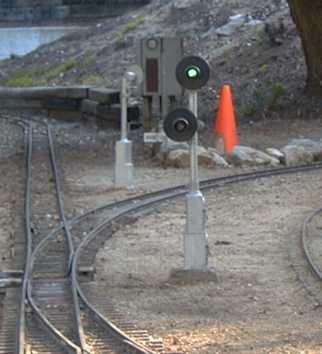 Dual target
signals are used to show the status of the main line or of a branch
line. If the top signal shows green, an associated turnout is
switched for the main and the main is clear. In this case, the main
is the curved path leading to the Nelson Tunnel. The top may show
yellow or red if the 2nd block ahead is occupied or red if the
block ahead is occupied. If the top signal is red and the lower
signal is lit, then the turnout associated is set for a diverging
route off the main. A lower yellow signal indicates that the
diverging block ahead is clear and a red indicates that the
diverging block ahead is blocked.
Dual target
signals are used to show the status of the main line or of a branch
line. If the top signal shows green, an associated turnout is
switched for the main and the main is clear. In this case, the main
is the curved path leading to the Nelson Tunnel. The top may show
yellow or red if the 2nd block ahead is occupied or red if the
block ahead is occupied. If the top signal is red and the lower
signal is lit, then the turnout associated is set for a diverging
route off the main. A lower yellow signal indicates that the
diverging block ahead is clear and a red indicates that the
diverging block ahead is blocked.
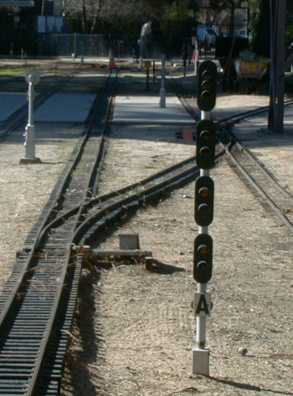 Several of the
signals have 3 or 4 sections depending on the complexity of the
following trackwork. In this case, the signal shows the status of
the main, and 3 subsequent nested diverging tracks.
Several of the
signals have 3 or 4 sections depending on the complexity of the
following trackwork. In this case, the signal shows the status of
the main, and 3 subsequent nested diverging tracks.
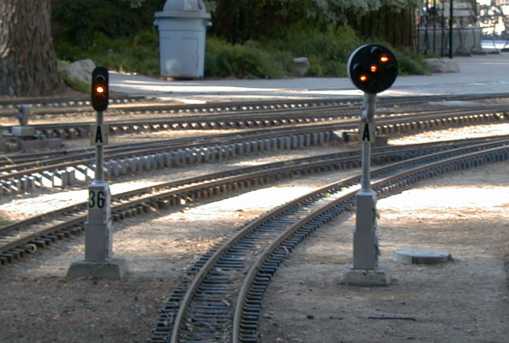 A couple of the
signals are Pennsy style position type indicators. A horizontal bar
is the same as a red.
A couple of the
signals are Pennsy style position type indicators. A horizontal bar
is the same as a red.
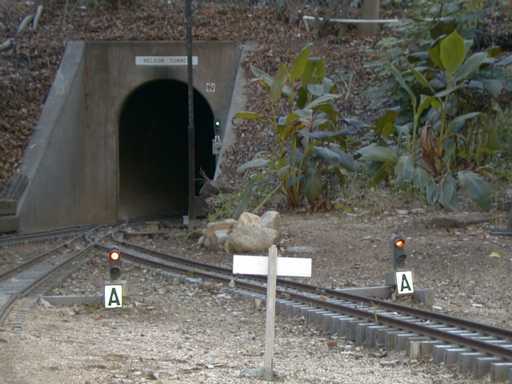 Several spots on
station or yard tracks are protected with dwarf signals. These are
absolute signals leaving the New Sherwood station. On the east
entrance to the Nelson tunnel is an absolute target signal.
Several spots on
station or yard tracks are protected with dwarf signals. These are
absolute signals leaving the New Sherwood station. On the east
entrance to the Nelson tunnel is an absolute target signal.
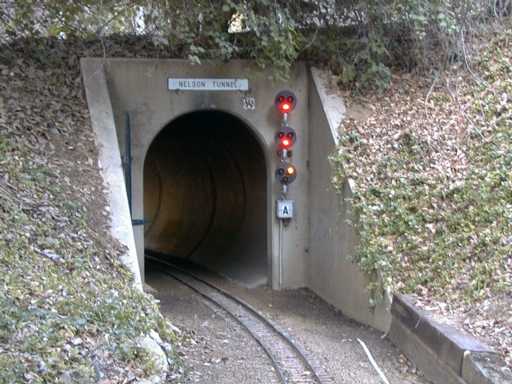 At the
other end of the Nelson tunnel is a stack that shows the status of
the main as it passes New Sherwood Station and the status of the
two station tracks in New Sherwood Station. The engineer can use
these signals to determine how the turnouts on the other side of
the tunnel are set so that he can select his desired route upon
leaving the tunnel. In this case, the turnouts are aligned for
station track 2.
At the
other end of the Nelson tunnel is a stack that shows the status of
the main as it passes New Sherwood Station and the status of the
two station tracks in New Sherwood Station. The engineer can use
these signals to determine how the turnouts on the other side of
the tunnel are set so that he can select his desired route upon
leaving the tunnel. In this case, the turnouts are aligned for
station track 2.
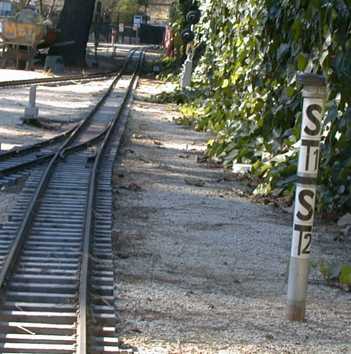 Turnouts are controlled by
the engineer with the aid of switches set on posts near the track.
After reading the signals, the engineer can determine if needs to
throw a turnout to select his route. This control selects between
New Sherwood Station track 1 or track 2. Track 1 is the "main" as
indicated by the following signal.
Turnouts are controlled by
the engineer with the aid of switches set on posts near the track.
After reading the signals, the engineer can determine if needs to
throw a turnout to select his route. This control selects between
New Sherwood Station track 1 or track 2. Track 1 is the "main" as
indicated by the following signal.
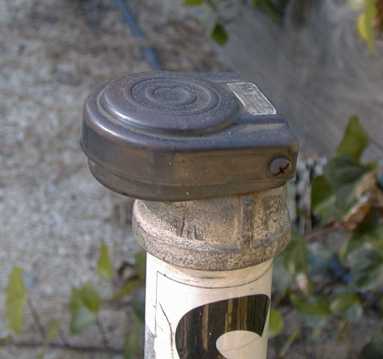 The switch
itself is just a foot treadle switch mounted on a piece of pipe.
These switches have proven to be durable and can be activated just
by mashing the top with a fist or the flat of a hand.
The switch
itself is just a foot treadle switch mounted on a piece of pipe.
These switches have proven to be durable and can be activated just
by mashing the top with a fist or the flat of a hand.
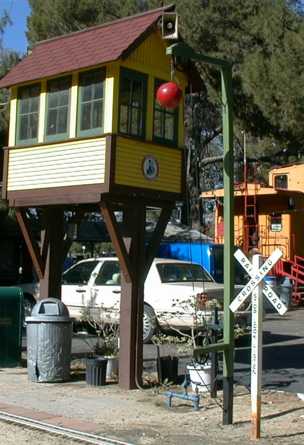 This isn't part of the automatic signal
system. The highball signal hasn't been used by real railroads for
at least 150 years.
This isn't part of the automatic signal
system. The highball signal hasn't been used by real railroads for
at least 150 years.
© 2000-2001 George Schreyer
Created Dec 31, 2000
Last Updated Jan 3, 2001